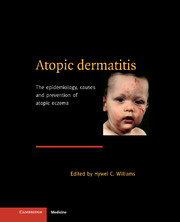Book contents
- Frontmatter
- Contents
- List of contributors
- Foreword Georg Rajka
- Preface
- Part I The nature of the problem
- Part II Descriptive studies which indicate the size of the problem
- Part III Analytical studies which point to causes of atopic dermatitis
- 8 Genetic epidemiology of atopic dermatitis
- 9 Fetal and perinatal origins of atopic dermatitis
- 10 Social factors and atopic dermatitis
- 11 The ‘old mother’ hypothesis
- 12 The possible role of environmental pollution in the development of atopic dermatitis
- 13 Atopic dermatitis in migrant populations
- 14 The role of inhalant allergens in atopic dermatitis
- 15 Dietary factors in established atopic dermatitis
- Part IV Intervention studies
- Part V Lessons from other fields of research
- Part VI Conclusions
- Additional information
- Index
- Plate section
8 - Genetic epidemiology of atopic dermatitis
from Part III - Analytical studies which point to causes of atopic dermatitis
Published online by Cambridge University Press: 17 August 2009
- Frontmatter
- Contents
- List of contributors
- Foreword Georg Rajka
- Preface
- Part I The nature of the problem
- Part II Descriptive studies which indicate the size of the problem
- Part III Analytical studies which point to causes of atopic dermatitis
- 8 Genetic epidemiology of atopic dermatitis
- 9 Fetal and perinatal origins of atopic dermatitis
- 10 Social factors and atopic dermatitis
- 11 The ‘old mother’ hypothesis
- 12 The possible role of environmental pollution in the development of atopic dermatitis
- 13 Atopic dermatitis in migrant populations
- 14 The role of inhalant allergens in atopic dermatitis
- 15 Dietary factors in established atopic dermatitis
- Part IV Intervention studies
- Part V Lessons from other fields of research
- Part VI Conclusions
- Additional information
- Index
- Plate section
Summary
Family studies
The progress in the treatment of diseases caused by infection and malnutrition has changed the disease spectrum in developed and developing countries. Environmental diseases are nowadays being out-numbered by others which are entirely or partly genetically determined such as atopic dermatitis (AD), which has become one of the most common diseases of childhood (Schultz Larsen et al., 1996). Since the classical and comprehensive study of Cooke and van der Veer in 1916 it has been known that allergy runs in families. They found that if one parent was allergic, then nearly 50% of the children likewise had allergy; if both parents were allergic, then so too were 75% of their offspring. After the discovery of transmission of antibodies (reagins) in the 1920s, the road was opened for the definition of atopy and the underlining of the relationship of atopic dermatitis to the atopic diathesis. That common genes rather than common family environment causes this familial aggregation has been substantiated by several extensive publications (Edgren, 1943; Schwartz, 1952; Schnyder, 1960), but controversy has existed about the mode of inheritance. All types of Mendelian framework have been suggested, but in the 1960s the available data strongly indicated atopy as being polygenic and multifactorially determined, which means that several genes (polygenic) as well as genetic and environmental factors (multifactorial) determine the expression of the disease (Arsdel & Motulsky, 1959; Leigh & Marley, 1967).
- Type
- Chapter
- Information
- Atopic DermatitisThe Epidemiology, Causes and Prevention of Atopic Eczema, pp. 113 - 124Publisher: Cambridge University PressPrint publication year: 2000
- 9
- Cited by



